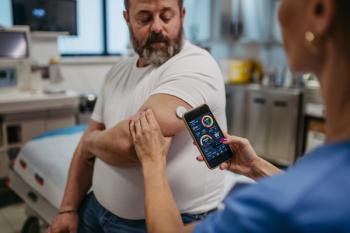
- December 2020
- Volume 88
- Issue 12
Pharmacists Play a Vital Role in Diabetes Management
Educating patients about medication adherence and understanding and monitoring A1C and fasting glucose levels improves health outcomes.
Based on 2018 data, about 34.2 million individuals have diabetes, representing 10.5% of the US population, according to the CDC’s National Diabetes Statistics Report, 2020.1
Just 19.2% of US adults 18 years or older with diagnosed diabetes met the following goals from 2013 to 2016: glycated hemoglobin A1C (HbA1C) value less than 7%; being a nonsmoker; blood pressure less than 140/90 mmHg; and non—high-density lipoprotein cholesterol less than 130 mg/dL.
The results of a systematic review of 44 studies showed that medication therapy management (MTM) services improved drug regimen adherence and appropriateness.2 Long-term complications can be prevented when patients have well-controlled diabetes, and pharmacists can play a critical role through MTM (figure).3
Evidence shows that pharmacists can improve diabetes health outcomes through the provision of MTM services.3,4 One study evaluated an MTM pilot program that included pharmacists as part of a multi-disciplinary team at a federally qualified health center (FQHC) involving patients with uncontrolled diabetes.3 Fifty-seven patients met the inclusion criteria and were enrolled in the 6-month study; 37 individuals completed the program and had an average 15% reduction in HbA levels (P < .05), demonstrating the important role that pharmacists play in diabetes MTM services.3 Pharmacist-provided MTM services were also evaluated in 10 FQHCs in Ohio, and 60% of patients achieved HbA1C levels of less than 9%.4
One pre-post, longitudinal study evaluated the impact of pharmacist-provided MTM services on employees with diabetes.5 After 1 year, patients’ HbA1C levels decreased by approximately 0.27 from baseline.5 The study results also showed that patients’ disease state knowledge increased and quality of life improved.5 One study evaluated MTM services in rural communities for patients with diabetes and/or hypertension.6 Community-based and telephonic pharmacist services were implemented as a combined approach to MTM. Positive trends were reported for diastolic blood pressure, fasting blood glucose, and postprandial glucose.6
In an interview with Pharmacy Times®, Bhavana Mutha, RPh, BCMAS, BCMTMS, chair of the Examination Advisory Board for the National Board of Medication Therapy Management, discussed the critical role that pharmacists play in diabetes MTM services through educating patients about the importance of medication adherence and understanding and monitoring HbA1C and fasting glucose levels. Mutha emphasized that as the coronavirus disease 2019 pandemic continues, pharmacists have become more involved in the provision of MTM services through telehealth. Pharmacists play an integral role in the multidisciplinary team and serve as the bridge between patients and physicians, which can promote effective communication and improve health outcomes.
“Many platforms now support the data transmission from patient to provider in real time and have a quick turnaround for clinical interventions,” Mutha said.
CASE STUDY AND COUNSELING PEARLS
TM is a 55-year-old man who recently received a diagnosis of type 2 diabetes (T2D) and started metformin therapy 2 weeks ago. During a targeted medication review, the pharmacist counsels TM about his new drug regimen as well as other important diabetes education points.
Metformin is recommended as a first-line medication for patients with T2D for initial treatment, according to American Diabetes Association guidelines.7 Gastrointestinal (GI) adverse effects (AEs) may occur with metformin, including bloating, diarrhea, nausea, and stomach cramping, so it is important to gradually increase the dose.8 Metformin should be taken with food to minimize GI AEs.8
TM was prescribed the metformin extended-release formulation, which may cause fewer GI AEs.8 Metformin extended-release tablets should be swallowed whole and not broken, chewed, or crushed. Lactic acidosis is a rare but serious AE associated with metformin that usually occurs in patients with other conditions, including cardiovascular, hepatic, and renal dysfunction. If any of the following lactic acidosis symptoms occur, it is important to seek immediate emergency medical attention: abdominal discomfort, decreased appetite, diarrhea, fast or shallow breathing, severe muscle cramping or pain, unusual tiredness, or weakness.8
The pharmacist advises TM that an HbA1C level test provides information about his average blood glucose levels over approximately 3 months and should be performed at least 2 times a year, with the goal being less than 7%.9 The target fasting blood glucose should be 80 mg/dL to 130 mg/dL, and postprandial, or 2 hours after the start of a meal, should be less than 180 mg/dL.9
Because lifestyle modifications also play an important role in diabetes management, the pharmacist recommends that TM exercise approximately 150 minutes per week.10 Additionally, the pharmacist refers him to a registered dietitian nutritionist for nutrition counseling, as weight loss of at least 5% is recommended.10 The eating plan should include nonstarchy vegetables, minimal added sugars, fruits, whole grains, and dairy products.11
Jennifer Gershman, PharmD, CPh, is a drug information pharmacist and Pharmacy Times® contributor who resides in South Florida.
REFERENCES
- National diabetes statistics report 2020. Centers for Disease Control and Prevention. Accessed September 3, 2020. https://www.cdc.gov/diabetes/pdfs/data/statistics/nation- al-diabetes-statistics-report.Pdf
- Viswanathan M, Kahwati LC, Golin CE, et al. Medication therapy management interventions in outpatient settings: a systematic review and meta-analysis. JAMA Intern Med. 2015;175(1):76-87. doi:10.1001/jamainternmed.2014.5841
- Ndefo UA, Moultry AM, Davis PN, Askew R. Provision of medication therapy management by pharmacists to patients with type-2 diabetes mellitus in a federally qualified health center. P T. 2017;42(10):632-637.
- Rodis JL, Capesius TR, Rainey JT, Awad MH, Fox CH. Pharmacists in federally qualified health centers: models of care to improve chronic disease. Prev Chronic Dis. 2019;16:E153. doi:10.5888/pcd16.190163
- Pinto SL, Kumar J, Partha G, Bechtol RA. Pharmacist-provided medication ther- apy management (MTM) program impacts outcomes for employees with diabetes. Popul Health Manag. 2014;17(1):21-27. doi:10.1089/pop.2012.0124
- Johnson M, Jastrzab R, Tate J, et al. Evaluation of an academic-community partnership to implement MTM services in rural communities to improve pharmaceu- tical care for patient with diabetes and/or hypertension. J Manag Care Spec Pharm. 2018;24(2):132-141. doi:10.18553/jmcp.2018.24.2.132
- American Diabetes Association. Pharmacologic approaches to glycemic treatment: Standards of Medical Care in Diabetes-2020. Diabetes Care. 2020;43(suppl 1):S98- S110. doi:10.2337/dc20-S009
- Metformin (oral route). Mayo Clinic. Updated July 1, 2020. Accessed September 4, 2020. https://www.mayoclinic.org/drugs-supplements/metformin-oral-route/descrip- tion/drg-20067074
- American Diabetes Association. Glycemic targets. Diabetes Care. 2017;40 (suppl 1):S48-S56. doi:10.2337/dc17-S009
- American Diabetes Association. Facilitating behavior change and well-being to improve health outcomes: Standards of Medical Care in Diabetes—2020. Diabetes Care. 2020;43(suppl 1):S48-S65. doi:10.2337/dc20-S005
Articles in this issue
almost 5 years ago
Consider Impact of Certain Medications on Brain Functionalmost 5 years ago
Select High-Alert Medications Require Cautionalmost 5 years ago
Statins Are the Cornerstone of Lowering Cholesterol Levelsalmost 5 years ago
Acute Coronary Syndrome Is a Medical Emergencyalmost 5 years ago
Providers Have Duty to Warn About Patient Threatsalmost 5 years ago
Thrifty Mac Pharmacy Delights Patients and Staffalmost 5 years ago
Techs Play an Essential Role in TelepharmacyNewsletter
Stay informed on drug updates, treatment guidelines, and pharmacy practice trends—subscribe to Pharmacy Times for weekly clinical insights.


















































































































































































































